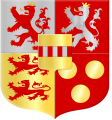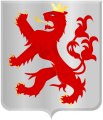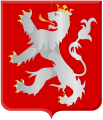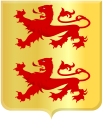Limburg-Stirum

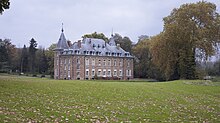
The Counts of Limburg-Stirum were imperial direct counts of the Holy Roman Empire since 1242, as the oldest branch of the Counts of Limburg and lords of the imperial direct rule of Styrum , which was mediated in 1806 . To date, branches exist in Belgium and the Netherlands.
ancestry
The male line of the Limburg-Stirum family goes back to the Counts of Berg-Altena and is the last still flourishing line of the important Rhenish-Westphalian dynasty of the Counts of Berg, which once branched out into numerous subordinate lines that governed the empire.
Engelbert I († 1189) founded the older Berg line , which ruled in the county of Berg (the later duchy). This county fell in 1225 through the marriage of Countess Irmingard to the ducal house of Limburg and Lower Lorraine and after its extinction in 1348 via Margaretha von Berg to the house Ravensberg , via her daughter Margarete von Ravensberg-Berg then to her husband Gerhard from the house Jülich , who later (1521) the states of Jülich-Berg-Ravensberg with the states of Kleve - Mark - Ravenstein were to merge to form the United Duchies of Jülich-Kleve-Berg , which were finally ruled by the House of Mark until 1609 , which in turn was an early branch of the Count von Berg -Altena.
Engelbert's brother Eberhard I von Berg-Altena († 1180) founded the younger Berg-Altena line and ruled the county of Altena . His sons Arnold and Friedrich established the lines of the Counts of Altena-Isenberg and the Counts of the Mark . Eberhard's older son Arnold von Altena built the Isenburg in Hattingen from 1193 , after which his son Friedrich von Isenberg was named. Friedrich was married to Sophie von Limburg († 1226), a daughter of Duke Walram IV of Limburg . Her son Dietrich von Altena-Isenberg (* around 1215; † 1301) had Hohenlimburg Castle built near Hagen around 1242 , named after his mother's family, and in 1243 received high and Go jurisdiction for part of the former father's property in the area of the lower lenne. The jurisdiction turned out to be a decisive prerequisite for the development of the territory of the newly formed County of Limburg in the area between the Ruhr , Lenne and Volme , which was in the middle of the County of Mark and bordered the Duchy of Westphalia in the east . Around 1232 there were military disputes between the Counts von der Mark on the one hand and Count Dietrich von Isenberg on the other over the legacy of Friedrichs von Isenberg, who was executed in 1226, the Isenberger Wirren . Much greater turmoil broke out in 1279 when Dietrich's cousin, Duke Walram V of Limburg, died. In the Limburg succession dispute and the resulting battle at Worringen in 1288, Dietrich was on the side of Archbishop of Cologne Siegfried von Westerburg . The victor of the battle, Duke Johann I von Brabant , stormed the Hohenlimburg in retrospect and forced Dietrich and his family to flee to Styrum , where he laid the foundation stone of the Styrum Castle on the existing estate , which became the center of an imperial rule of Styrum ( until 1806). Count Dietrich founded the Count House of Limburg, but still called himself Count von Isenberg until his death.
Already at the beginning of the 14th century, the Count House Limburg split into the main lines Limburg-Limburg (older line) and Limburg- Styrum . The Count House Limburg- Broich split off from the Limburg-Hohenlimburg line in the second half of the 14th century . While the Limburg-Styrum house still exists today, the Limburg and Broich branches died out in the 15th and 16th centuries.
Hohenlimburg castle and lordship shared ( condominium ) the count houses Limburg-Broich and Neuenahr since 1460 ; Limburg-Broich's share fell from 1509 to 1542 to Count Wirich V. von Daun-Falkenstein , after which the Counts of Neuenahr were sole regents until 1589; from 1592 to 1807/08 the county belonged to the house of Bentheim-Tecklenburg , which still owns the Hohenlimburg today.
Division into one Dutch and two German lines
Count Georg von Limburg-Styrum married Irmgarde von Wisch, Herrin zu Wisch , Wildenborch , Overhagen and Lichtenvoorde in 1539 , who inherited her uncle, the last Count of Bronkhorst and Borculo . Her son Hermann Georg von Limburg-Styrum inherited these Dutch possessions and has lived in Gelderland ever since . His grandson Jobst von Limburg-Styrum married Countess Maria von Schauenburg and Holstein-Pinneberg in 1591 , daughter of Otto IV. Von Holstein-Schaumburg and heir to the Westphalian rule of Gemen , which has now remained in the family's possession for two centuries.
In 1644 the three sons of Herman Otto I divided the possessions among themselves and established three lines:
- Limburg-Styrum-Bronkhorst-Borculo : Otto received the Dutch possessions and founded the older line that still existed in the Netherlands and Belgium ; around 1700 the Lords of Wisch and Wildenborch were sold to the House of Nassau-Siegen ; The Bronkhorst estate was sold in 1721, the Borculo estate in 1726 and the Lichtenvoorde estate in 1727 due to excessive indebtedness. All still living descendants of the Dutch branch descend from Otto Ernst (1685–1769); individual descendants went from the Netherlands to Belgium as well as to Germany, Sweden and Finland. The count was confirmed to the branch by Napoleon in 1812 ; In 1814 he was accepted into the nobility of the Kingdom of the Netherlands as Graaf van Limburg Stirum . Willem Bernard (1795-1889), son of Samuel John, founded the Belgian branch, which carries the title of count with the surname de Limburg Stirum . The Belgian line is now based at Kasteel Huldenberg and the Château de Walzin.
- Limburg-Styrum-Gemen : Adolf Ernst received the Westphalian rule of Gemen and from 1677 (until 1772) also the Central Swabian rule of Illereichen ; Raesfeld Castle was added in 1733 . After this line died out in 1800, Gemen was inherited by the Barons of Boyneburg -Bömelberg and in 1806 was mediatized to the Principality of Salm .
- Limburg-Styrum-Styrum : Moritz received Styrum from the estate division of Mülheim an der Ruhr with the rule there . In 1766 (until 1777) Idar-Oberstein with Oberstein Castle was added for a short time ; this line was mediated to the Grand Duchy of Berg during the formation of the Napoleonic Rhine Confederation in 1806 and expired in 1809; The last Count Ernst (1736–1809) bequeathed the property with Styrum Castle to his sister-in-law Maria Margaretha von Humbracht , who in 1825 passed it on to the long-time rent master Dr. Marcks sold. In 1890, August Thyssen acquired Styrum Castle to meet the water needs of his nearby Thyssen & Co., founded in 1871, and built a waterworks there, which is now the Aquarius Water Museum. The castle, which was last used as an estate, became a residence under Thyssen - but not for the Thyssen family, but for directors of the company; In 1959 it became the property of the city of Mülheim.
Bronkhorst Castle
Borculo Castle
Lichtenvoorde Castle
Representative
Some well-known members of the family are:
- Eberhard I of Limburg-Styrum (1252–1304), Count of Isenberg-Limburg, Lord of Styrum, founder of the Limburg-Styrum line
- Dietrich III. von Limburg-Styrum († 1398), German nobleman, by heir Herr von Styrum
- Eberhard von Limburg-Styrum (* ~ 1380; † ~ 1424), German nobleman, by inheritance Herr von Styrum
- Wilhelm I of Limburg-Styrum († 1459), German nobleman, by heir Herr von Styrum
- Adolf von Limburg-Styrum († 1506), nobleman and by inheritance lord of Styrum
- Wilhelm II of Limburg-Styrum († 1521), nobleman, lord of Styrum by inheritance
- Georg von Limburg-Styrum (* ~ 1500–1552), nobleman, Count of Limburg, by inheritance lord of Styrum
- Agnes von Limburg-Styrum († 1570), abbess at Freckenhorst Abbey
- Hermann Georg von Limburg-Styrum (1540–1574), nobleman, by heir Count von Bronckhorst, lord of Styrum
- Jobst von Limburg-Styrum (1560–1621), Count von Bronckhorst, Lord of Styrum, Borculo and Lichtenvoorde, Lord of the Banners of Geldern and Zutphen
- Metta von Limburg-Styrum (1561–1622), abbess at Freckenhorst Abbey
- Agnes von Limburg-Bronkhorst-Styrum (1563–1645), abbess of the Elten, Vreden, Borghorst and Freckenhorst monasteries
- Hermann Otto I of Limburg-Styrum (1592–1644), military, Count von Bronckhorst and Lord of Borculo, Gemen, Lichtenvoorde and Styrum
- Otto von Limburg-Styrum (1620–1679), nobleman and military, by descent Count of Limburg, by heir Count von Bronckhorst and Lord of Borculo, lord of the banner of Geldern and Zutphen
- Adolf Ernst von Limburg-Styrum (1622–1657), Count of Limburg-Styrum, Lord of Gemen
- Agnes Maria von Limburg-Styrum (1631–1646), elected abbess at Freckenhorst Abbey
- Moritz von Limburg-Styrum (1634–1664), German nobleman, by descent Count von Limburg, by heir Herr von Styrum
- Hermann Otto II of Limburg-Styrum (1646–1704), Imperial Field Marshal General
- Moritz Hermann von Limburg-Styrum (1664–1703), German nobleman, Count von Limburg by descent, Herr von Styrum by heir
- Otto Ernst Leopold von Limburg-Stirum (1684–1754), Lord von Gemen and Raesfeld, General of the Imperial Army
- Christian Otto von Limburg-Styrum (1694–1749), German nobleman, by descent Count of Limburg, by heir Herr von Styrum
- August von Limburg-Stirum (1721–1797), from 1770 to 1797 Prince-Bishop of Speyer
- Karl Joseph August von Limburg-Styrum (1727–1760), German nobleman, by descent Count of Limburg, by heir Lord of Styrum
- Philipp Ferdinand von Limburg-Styrum (1734–1794), Count of Limburg-Styrum, Lord of Styrum, lover of Princess Tarakanova
- Ernst Maria von Limburg-Styrum (1736–1809), Count of Limburg-Styrum, last lord of Styrum (mediatized in 1806)
- Leopold von Limburg Stirum (1758-1840), Dutch politician, took power in the Netherlands in 1813 to restore the monarchy
- Friedrich zu Limburg-Stirum (1835–1912), German diplomat, politician and State Secretary in the Foreign Office of the German Empire
- Friedrich Wilhelm zu Limburg-Stirum (1871–1951), German administrative officer and manor owner
- Johan Paul van Limburg Stirum (1873–1948), Dutch diplomat, Governor General of the Netherlands Indies, Dutch envoy in Berlin (1925–1936) and in London (1936–1939)
- Richard zu Limburg-Stirum (1874–1931), German manor owner and administrative officer
- Charles de Limburg Stirum (1906–1989), Belgian Senator, Grand Master of King Leopold III. of Belgium
Coat of arms (1640)
The coat of arms consists of the following components:
Coat of arms with cloak and crown of glory
Reign of Bronkhorst
Reign wipe
Borculo reign
See also
literature
- Genealogical handbook of the nobility, Gräfliche Häuser A Volume II, 1955; Digitized
- Michel Huberty, Alain Giraud et F. et B. Magdelaine, L'Allemagne dynastique, t. VII, 1991, 767 p., 28 cm ( ISBN 2-901138-07-1 )
- Heinz Gollwitzer : The gentlemen. The political and social position of the mediatized 1815–1918. A contribution to German social history. Vandenhoeck & Ruprecht, Göttingen 1964.
- Marcellin Lagarde, "Histoire du Duché de Limbourg", A. Jamar, Bruxelles 1848;
- W. Gf v. Limburg Stirum, "Stamtafel der Graven van Limburg Stirum", 's Gravenhage 1878;
- AMHJ Stokvis, "Manuel d'Histoire, de Genealogie et de Chronologie de tous les États du Globe", Tome III, Leiden 1890-93;
- WK Prins v. Isenburg, "Family Tables for the History of the European States", 2nd edition, Marburg / Lahn, 1953.
- Hanswerner Sandgathe: Styrum. Counts subjects citizens. Oberhausen 2001.
Web links
- Document registers from the Limburg-Styrum archive / digital Westphalian document database (DWUD)
- Count of Limburg-Styrumsche Archive, North Rhine-Westphalia State Archive, Duisburg
Individual evidence
- ↑ County of Limburg. In: Gerhard Taddey (Hrsg.): Lexicon of German history . People, events, institutions. From the turn of the times to the end of the 2nd World War. 2nd, revised edition. Kröner, Stuttgart 1983, ISBN 3-520-81302-5 , p. 739.
- ↑ Günter Aders / H. Horstmann / Adam L. Hulshoff et al. a .: The Counts of Limburg-Stirum and their possessions, T. I-III, Vol. 1–9, Assem / Amsterdam / Münster 1963–1976












